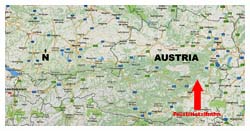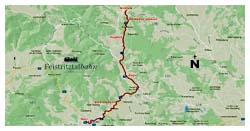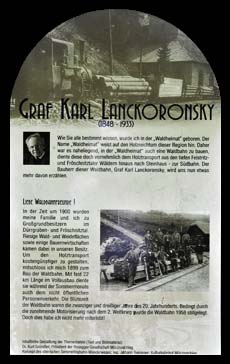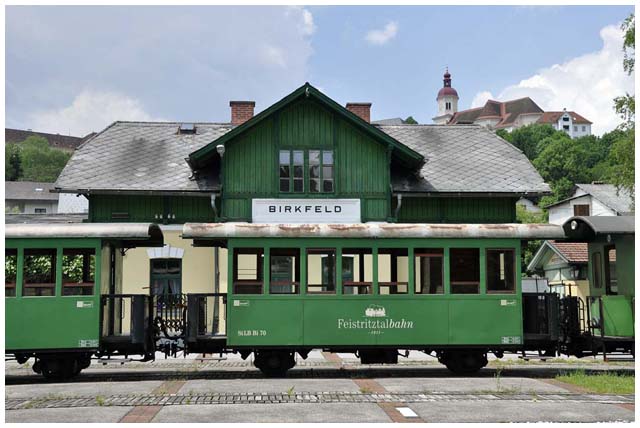
Feistritztalbahn
Birkfeld Austria
N47.35383 E15.69915
 The Feistritztalbahn operating company was formed in 1999 to run heritage trains along the 760 millimeter (about 2 1/2 feet, or 30 inches) narrow gauge railway 24.1 kilometres (15 miles) long in the state of Styria, Austria. The railway follows the valley of the Feistritz River between Birkfeld, the northern terminus, to just south of Anger where the railway crosses the Feistritz River heading southwest over hill and dale to Weiz, the southern terminus. Along this route there are 2 tunnels and 8 viaducts encountered with grades as steep as 1 in 40 (2.5 percent). See this grade chart.
The Feistritztalbahn operating company was formed in 1999 to run heritage trains along the 760 millimeter (about 2 1/2 feet, or 30 inches) narrow gauge railway 24.1 kilometres (15 miles) long in the state of Styria, Austria. The railway follows the valley of the Feistritz River between Birkfeld, the northern terminus, to just south of Anger where the railway crosses the Feistritz River heading southwest over hill and dale to Weiz, the southern terminus. Along this route there are 2 tunnels and 8 viaducts encountered with grades as steep as 1 in 40 (2.5 percent). See this grade chart.
Late in the nineteenth century an idea to build a narrow gauge line from Weiz via Anger, Birkfeld, Rattan, and Rettenegg to Steinhaus on the Semmeringbahn appeared. In late 1885 an engineer named Lichtenfels submitted a study to the railway authorities for a metre gauge light railway running from Weiz to Rettenegg with a connection from Weiz south to Gleisdorf. The only result of this study was the construction of a standard gauge railway between Weiz and Gleisdorf. In 1901 the standard gauge company decided to build a standard gauge line along a portion of Lichtenfels proposed route as far as Anger before continuing east. The company quickly realized standard gauge was not possible due to the terrain so their plan was withdrawn by 1904.
In 1907 it was finally realized that the only viable option for construction through that countryside would be a narrow gauge line. A gauge of 760 millimetres was chosen for the route. Government permission for construction was requested in 1907 and granted in 1909. Work started shortly after that taking only 27 months to complete. One of the most difficult tasks that first July was construction of the Grub Viaduct at 276 meter long with 13 arches built with the new concept of reinforced concrete, the first construction of this kind in Austria. The Official opening of the line between Weiz and Birkfeld took place 14 Dec 1911 at Anger with regular train service commencing the next day. Construction from Birkfeld north to Rettenegg was put off for a later time. The line was operated by the Austrian Imperial State Railway on behalf of the Weiz-Birkfeld Light Railway Company.
With World War I in progress construction to Rettenegg was started in the Spring of 1917 by the Austrian Army utilizing Italian prisoners of war. Insufficient numbers of prisoners, most of whom were in poor physical condition, slowed construction to a crawl. With the War's end in 1918 and the collapse of Imperial Austria all construction work halted. The economic conditions at that time created a final end to any thoughts of completing the line to Rettenegg.
In 1920 the company "Feistritztaler Bergbau und Industrie AG" decided to develop the brown coal deposits at Ratten so they purchased the concession for the partly finished line. They completed the line to Ratten and on 11 May 1922 requested a permit to operate from the government but it was denied due to the low quality of the construction work and poor condition of their rolling stock. Undeterred the company began illegal operation of the line. Passenger traffic consisted mostly of miners who rode to work at the coal pits in Ratten. The coal wagons used between Birkfeld and Ratten were without vacuum brakes and incompatible with the wagons on the Birkfeld-Weiz line thereby forcing the coal to be trans-loaded at Birkfeld.
Eventually the Birkfeld-Ratten line was transferred to the Weiz-Birkfeld Light Railway Company who improved the existing line then received approval to carry passengers. On 29 May 1930 railway President Wilhelm Miklas opened the 42 kilometer stretch between Weiz and Ratten. Passengers could now legally ride all the way between Weiz and Ratten but the proposed continuation of the line northeast from Ratten to Rettenegg was never built.
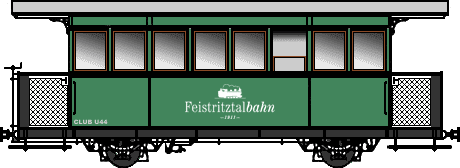
In 1942 the privately owned railway was transferred to the Steiermärkische Landesbahnen (StLB, The Styria State Railway Company, which is a transport company of the State of Styria. This company currently operates five railway lines with a total length of 124 kilometres). Traffic continued to Ratten until 1960 when the Ratten coal mine closed. With the increasing use of road transport even the purchase of modern diesel locomotives could not stop the downward economic spiral of the little railway.
During the 1970's steam hauled heritage trains were introduced between Weiz and Birkfeld and even on to Ratten. However, the success of the revived heritage trains could not disguise the fact that the financial success of the railway depended upon goods traffic. And this, with one exception, steadily shrank in the 1980's until the service to Ratten was eventually discontinued and the tracks removed between Ratten and Birkfeld. (It's now a bicycle path.) In the following years, the StLB gradually withdrew services, first to Anger, and finally to Oberfeistritz, where the only remaining commercial customer, Naintsch Mineralwerke, a talc mill, is located.
Finally the StLB withdrew services completely but the "Feistritztal-Bahn-Betriebs-Gmbh" company was formed under the leadership of the local tourist organizations to operate the heritage tourist trains. Due to the untiring efforts of its supporters the railway has now managed to achieve some measure of financial stability as an important local attraction vital to the local economy.
On 21 May 2015 the entire route from Weiz to Birkfeld was transferred from the government (StLB) to the Feistritztalbahn operating company for the sum of €1.
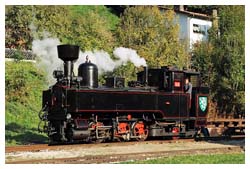
Number: U.8 "Teufenbach"
Wheel arrangement: 0-6-2T
Gauge: 760 mm (29.9 in.)
Builder: Krauss-Linz
Built: 1894
Fuel: Coal
Boiler pressure: 12 atm (176 psi)
Cylinder dia: 290 mm (11.4 in.)
Piston stroke: 400 mm (15.75 in.)
Drive wheel dia: 820 mm (32.2 in.)
Maximum speed: 35 kph (21.8 mph)
Krauss built these machines based on the tried and tested Steyrtal Railway locomotive (Steyrtalbahnlok). The frames and engine were adopted almost unchanged, boilers, fireboxes, and water tanks were extended. This re-developed Steyrtalbahnlok was able to haul a load of 515 tonnes. Their maximum speed was set at 35 kph.
In 1897 it was the practice for newly constructed narrow gauge locomotive series to receive their letter designation from the first letter of the name of their place of employment. Hence, "U" for Unzmarkt, was chosen for this series of locomotive as it was the starting point on the Murtalbahn.
The U series locomotives proved themselves so well that they were ordered in large quantities by almost all operators of European narrow gauge railway lines including the Zillertalbahn. The last specimen of the U series was built for the StLB in 1922. Due to the large quantity built numerous locomotives are still in operation today on museum and tourist railways in Europe. Some are stuffed and mounted as locomotive monuments. U8 is apparently located at Birkfeld but isn't operational.
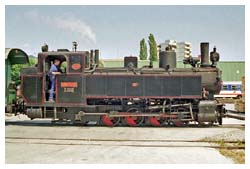
Number: Kh.101
Wheel arrangement: 0-10-0T
Gauge: 760 mm (29.9 in.)
Builder: Krauss-Linz
Built: 1926
Fuel: Coal Boiler pressure: 12.0 atm (176 psi)
Cylinder dia: 400 mm (15.75 in.)
Piston stroke: 400 mm (15.75 in.)
Drive wheel dia: 820 mm (32.3 in.)
Maximum speed: 25 kph (15.5 mph)
In 1926 a similar machine, number Kh.101, was delivered to the Murtalbahn. In 1930 another engine, Kh.111, went to the Feistritztalbahn for service between Birkfeld to Ratten. Both machines were transferred to the Steiermärkische Landesbahnen (StLB) as the successor after the dissolution of the private railway companies. Kh.111 belongs to Club 760 but is non-operational and rests at Frojach on the Murtalbahn. As of 2017 Kh.101 is operational for tourist train service on the Feistritztalbahn. The two rear connecting rods to the last pair of driving wheels have been removed so effectively the locomotive is now a 0-8-2T type.
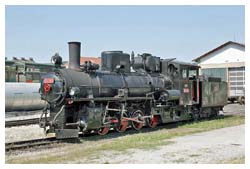
Number: 83-180
Wheel arrangement: 0-8-2
Gauge: 760 mm (29.9 in.)
Builder: Ðuro Ðakovic
Built: 1949
Fuel: Coal Boiler pressure: 12 atm (176 psi)
Cylinder dia: 430 mm (16.9 in.)
Piston stroke: ? mm (? in.)
Drive wheel dia: 900 mm (35.4 in.)
Maximum speed: 35 kph (21.8 mph)
In 1878 Austria-Hungary occupied the Ottoman (Turkish) countries of Bosnia and Herzegovina integrating them as regions with special status into the then double monarchy. Shortly thereafter railway construction began with the then exotic gauge of 760 millimetres, still known today as Bosnian gauge. The Bosnia and Herzegovina State Railways operated a growing, mostly difficult to traverse network, of 760 millimetre track. The end of the double monarchy made Bosnia-Herzegovina part of the new SHS State (The Slovenian, Croatian, and Serbian states were merged with the Kingdom of Serbia forming the then-known SHS State).
This forerunner to Yugoslavia expanded the 760 millimetre network extensively and combined the Bosnian-Herzegovina routes with Serbian routes. The need for additional locomotives was great as new routes to Belgrade were created. Since there were no locomotive factories in the SHS at that time, the locomotive production orders went to Budapest and to Jung/Jungenthal in Germany. Two Serbian private railways also ordered a total of 4 engines. After the establishment of Yugoslavia, further locomotives were needed. The Yugoslavian manufacturer Ðuro Ðakovic as well as the Budapest locomotive factory, which was renamed MÁVAG, delivered the last 83 series in 1948 and 1949.
Due to their long period of construction, and the large number of parts produced, the 83 series were able to keep operating for a long time. In 1966 the Austrian trade journal "Eisenbahn" published the official statistics of the Yugoslav State Railways. On 31 Dec 1965, the 83 series was still in use. Surviving 83 series engines are found not only in Bosnia and Herzegovina, as well as Serbia, but also in Croatia, Macedonia, Hungary, and Austria.
About 1975 the Austrian Club 760 succeeded in acquiring several Yugoslavian narrow gauge locomotives, including an 83 series, for preservation in a museum. In 1987 during celebrations for the 150th anniversary of the Austrian railways, number 83-076, which had been saved and externally restored although never been used is Austria, was acquired by Club 760 then lent to the Zillertalbahn after restoration at the steam engine plant in Meinigen. The last place in Yugoslavia to operate an 83 series engine was the Banovici coal mine because it was more powerful than their JZ 740 series diesel locomotives. Steam locomotive 83-180 was sold by the Banovici coal mine to Club U44 for use on the Feistritztalbahn in 1998, but wasn't transferred from Bosnia to Austria until 2001. In June of 2017 loco 83-180 was located beside the enginehouse at Birkfeld but reported as unserviceable.
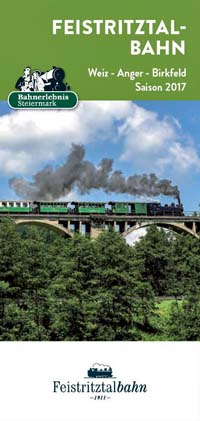
11 Dec 2010 - Feistritztalbahn Footplate Ride
14 Aug 2012 - Arnold Schwarzenegger on His 65th
18 Nov 2013 - "Sir Drefaldwyn" to Steam Again on Llanfair Line
15 Feb 2016 - Government Gives Green Light for Sale of the Feistritztalbahn
12 Jul 2017 - Sprayer Wrote "Sorry"
Club U44
Railfan Europe Net Picture Gallery
Lokomotiven und Wagen der Feistritztalbahn
Bahnbilder Photos (Link fails 26 Jul 2022)
Entlang der Gleise (Along the Tracks)
YouTube Double-Header Video 2006
HOe Scale Models
 100 Jahre FeistritztalbahnZehetner, Dietmar und Schellauf, Karl2011Sutton Verlag GmbH Hochheimer Strasse 59 Erfurt.Paperback96 pages, 16.5 x 23.5 cm, €20.00Available from Amazon.de
100 Jahre FeistritztalbahnZehetner, Dietmar und Schellauf, Karl2011Sutton Verlag GmbH Hochheimer Strasse 59 Erfurt.Paperback96 pages, 16.5 x 23.5 cm, €20.00Available from Amazon.deThe book is illustrated by more than 140 interesting black and white photos showing the 100 year history of the railway. They document the construction of the lines Weiz-Birkfeld and Birkfeld-Ratten, the development of freight and passenger traffic and the activities of Club U 44. The book invites you on a nostalgic journey on one of the most likeable narrow gauge railways in Austria. The text is in the German language.




